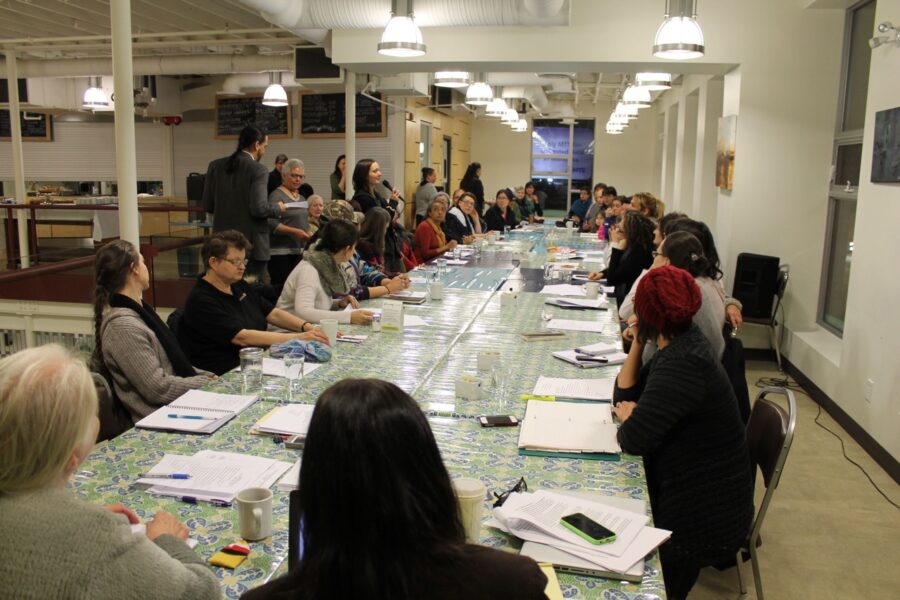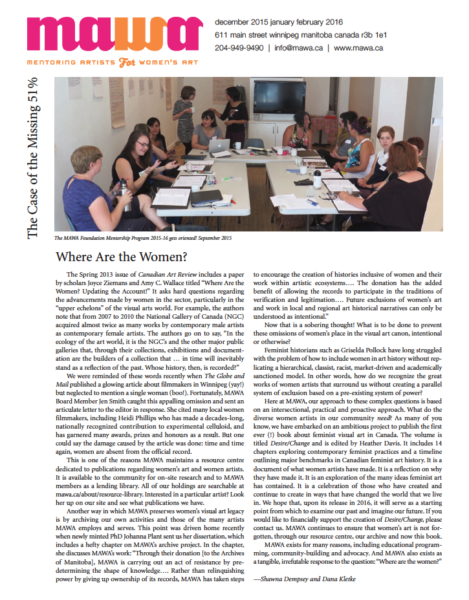
Walking with Our Sisters community conversation, Winnipeg, January 2014
Art in the Community
by Becca Taylor
For most of my career, I have worked to insert community collaborative art projects within the white walls of galleries and institutes, and community members into them as well. One of my challenges has been to ease the anxiety many people feel when entering art spaces—sites that have opaque protocols and their own complex language: the language of contemporary art. It can be very intimidating and uncomfortable. It is certainly unfamiliar to most people. So how DO we engage with the community? How do we get them into art spaces? How do we help them to relate to the work?
These questions have many different answers. But I believe that the most successful examples of socially engaged contemporary art practices are ones in which the community is able to take ownership of the work, ones that take place in the community (not galleries), and ones that take the time to create meaningful conversations with community members.
Community members need to be able to relate to art initiatives and to have their own/collective voice heard. People do not want to be talked for but engaged with; they want to be a part of the discussion. This work can extend beyond the goals, both conceptual and aesthetic, of the artist. It is no longer just the artist creating the work, but the community creating the work. The art itself becomes the act of conversation, organization, time together and commitment to the collective thought, idea, ideal or message.
Before Christi Belcourt’s Walking with Our Sisters commemorative art installation arrived in Winnipeg in 2014, the community was invited to a series of conversations, allowing them to be involved in fundraising, exhibition planning and ceremonies that would take place during the exhibition. The number of people at each conversation grew until there were over 50 community members sitting at the planning table. This was not unique to Winnipeg. The installation specifics are decided by each community that Walking with Our Sisters travels to, allowing each community to invest the installation with their issues, needs, histories and spiritual practices. Community members engage with Belcourt’s project because they have worked to make it happen in a way that matters to them.
Making a space in which the community is comfortable is another important aspect to the success of projects. Sometimes this means stepping outside of the white cubes of galleries and the hallowed halls of academia, and going into public spaces: parks, community centres, libraries, bars and the streets. Removing ourselves from the limitations of institutional physical space and all that it imposes can be freeing. It allows artists and community members to meet each other on the communities’ turf. Therefore we must be flexible regarding where art happens, in order to effectively engage with community.
Jaime Black’s REDress project adapts and adjusts to diverse spaces. This travelling installation has been exhibited in public parks and within museums. The work is not defined by the space, but rather transforms the space. The suspended red dresses create haunting reminders of Murdered and Missing Indigenous Women wherever they are installed. Another example is KC Adams’ Perception series, which exists entirely outside of white walls. Adams pairs portraits of Indigenous community members with text that contrasts racial stereotypes with the subjects’ own self-definitions. These works are exhibited exclusively within the public realm, on bus shelters, on billboards and in the windows of local businesses. For this project, daily commuters are Adams’ audience.
To be effective, a community-based art initiative must also be an open-ended exploration that allows the art itself to be moved and changed by the conversation. I find this to be particularly true in youth art initiatives. If youth aren’t being listened to, they stop talking. In order to be truly collaborative, it is essential that the artist constantly adapts to community needs, discards preconceptions and is willing to rework their project. This takes time. There is no way to “know” and respond to the complexities of a community overnight.
While I was curating Mapping Identities: A Decolonizing Art Practice, a partnership between mentoring artist Praba Pilar and young artists from Ndinawe Youth Resource Centre, we discovered that the needs and interests of the youth changed throughout the course of the workshops. As a result, the program and its expected outcomes were constantly shifting. The works in the exhibition are the result of being adaptable and letting the youth drive the conversation and creative process to reflect what they needed to address. We were there to help keep the project focused and safe, and to compile the work created over the course of six weeks into a final product they were proud of.
When it works, the feeling of collaborating with community to create an exhibition or project is indescribable. “Look at what we can do together!” To see people invested and taking ownership of their work, and talking to other community members about the issues imbedded in the artwork creates the seeds for change. Communities know what they need. We, as artists and curators, just need to listen and help them with our knowledge to make their/our projects successful.

